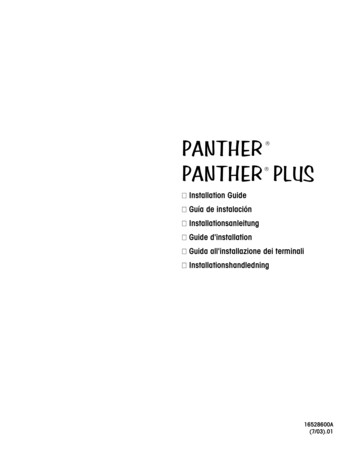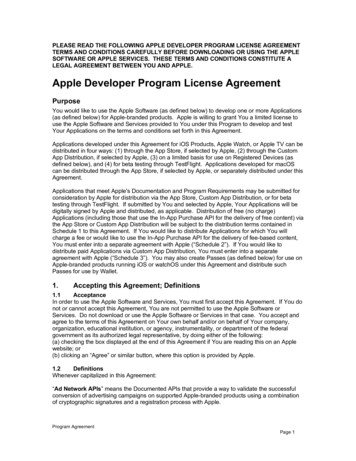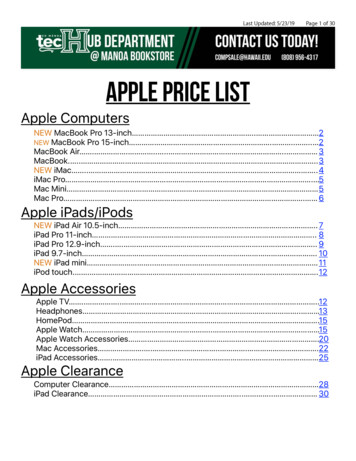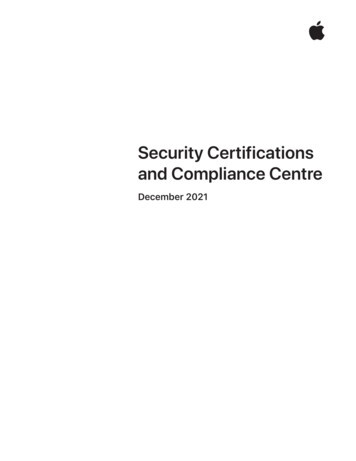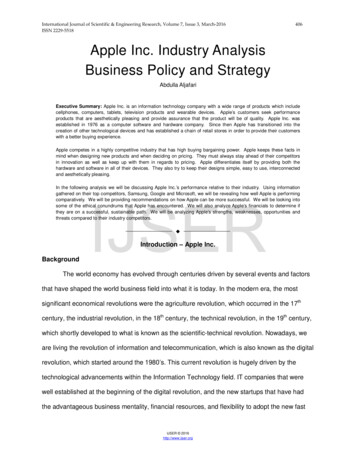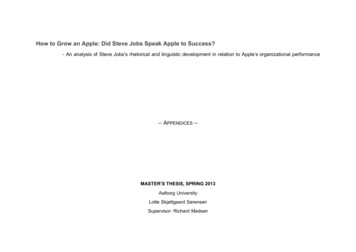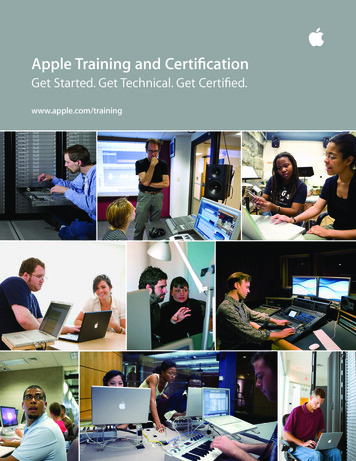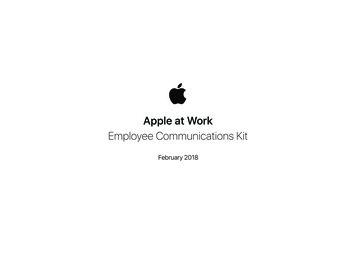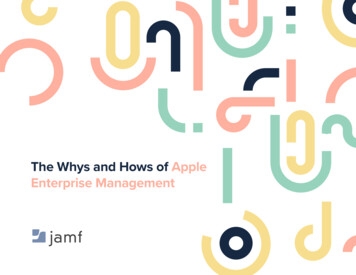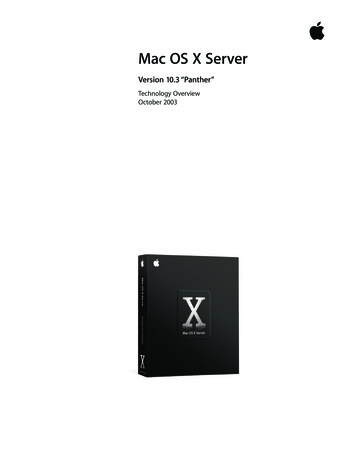
Transcription
Mac OS X ServerVersion 10.3 “Panther”Technology OverviewOctober 2003
Technology OverviewMac OS X ServerContentsPage 3IntroductionPage 4New in Version 10.3Page 5Managing Mac OS X ServerPage 7Robust Workgroup and Internet ServicesOpen Directory 2Workgroup ManagerFile and Print ServicesNetBoot and Network InstallNetworking and VPNMail ServicesWeb HostingEnterprise ApplicationsMedia StreamingPage 17Apple’s Directory Services ArchitecturePage 19Product DetailsPage 21Open Source ProjectsPage 23Additional Resources2
Technology OverviewMac OS X Server3IntroductionMac OS X Server combines the latest open source technologies with Apple’s industryleading manageability and ease of use. The result is a world-class server platform that’sboth easy and affordable to deploy and maintain.The power and simplicity of Mac OS X Server are a reflection of Apple’s operatingsystem strategy, one that favors open industry standards over proprietary technologies. It begins with a UNIX-based foundation with Mach 3, FreeBSD 4.8, and the latestadvances from FreeBSD 5 at the core. This kernel, known as Darwin, provides a stable,high-performance platform for developing groundbreaking applications and systemtechnologies. As Mac OS X continues to redefine the desktop computer operatingsystem, Mac OS X Server delivers industry-leading services that maximize the performance of Mac OS X and mixed-platform environments.Open source made easyMac OS X Server version 10.3 “Panther” is the fourth major release of Apple’s awardwinning server software, providing standards-based workgroup and Internet serviceswithout the complexity inherent in other UNIX-based solutions. Instead of developingproprietary server technologies, Apple has built on the best open source projects—Samba 3, OpenLDAP, Kerberos, Postfix, Apache, and more. Mac OS X Server integratesthese robust technologies and enhances them with a unified, consistent managementinterface. Powerful administrative tools permit novices to configure and maintain corenetwork services, while providing the advanced features and functionality required byexperienced IT professionals.Built on open standards, Mac OS X Server is compatible with existing network andcomputing infrastructures. It uses native protocols to deliver directory services, fileand printer sharing, and secure network access to Mac, Windows, and Linux clients.A standards-based directory services architecture offers centralized management ofnetwork resources using any LDAP server—even proprietary servers such as MicrosoftActive Directory or Novell eDirectory. The open source UNIX-based foundation makesit easy to port and deploy existing tools to Mac OS X Server.Best of all, Mac OS X Server fits easily into IT budgets everywhere. A complete suiteof workgroup and Internet services is included in the box, so network administratorscan get started right away. Mac OS X Server is available in 10-client and unlimitedclient editions and does not require additional per-user fees, making it an affordablesolution for organizations of any size.Mac OS X Server: for supporting Mac and Windows workgroups, deploying powerfulInternet services, and hosting enterprise applications—all with an ease of use that isuniquely Macintosh.
Technology OverviewMac OS X Server4New in Version 10.3The combination of powerful open source software and easy-to-use managementapplications in Mac OS X Server v10.3 highlights the rapid pace of innovation atApple and in the open source community at large. This latest release has more than150 new features, including:Xserve and Xserve RAIDMac OS X Server unleashes the power ofXserve, Apple’s 1U rack-optimized serverhardware. With phenomenal performance,massive storage capacity, high-bandwidthI/O, and integrated remote managementtools, Xserve running Mac OS X Server isan unparalleled server solution for businesses, schools, and research centers. Foreven more storage, Xserve RAID offers ahigh-availability, high-performance storagesolution in a 3U enclosure.Automatic Setup. Now configuring a rack of servers is as easy as configuring oneserver. The new Automatic Setup simplifies data center deployments by enablingadministrators to set up multiple servers from configurations stored in a directoryserver, an iPod, or any FireWire or USB storage device.Server Admin. This innovative application makes it easy to set up, manage, andmonitor the network services built into Mac OS X Server, such as Samba 3, Apache,DHCP, Postfix, and QuickTime Streaming Server—all from the same intuitive interface.Open Directory 2. Apple’s next-generation directory server delivers enterprise-classLDAPv3 directory services using OpenLDAP and Kerberos authentication. Advancedfeatures such as replication increase scalability and availability.Single sign-on. With support for Kerberos v5 built into Mac OS X and Mac OS XServer v10.3, Apple offers simpler and more secure access to network services. Userscan log in once, authenticate at the login window, and securely access all authorizednetwork services—without entering additional passwords.Samba 3. Apple is the first major operating system to ship with Samba 3. By integrating the latest release of the popular open source SMB/CIFS server, Mac OS XServer v10.3 can deliver high-performance, reliable file and printer sharing forWindows clients, as well as support for NT Domain services. In addition, users canaccess a single home directory from either Mac or Windows systems.VPN server. Apple provides an integrated client/server solution for secure networkaccess from outside the firewall. The new VPN server in Mac OS X Server supportsboth PPTP and L2TP/IPSec for compatibility with Mac, Windows, and Linux clients.Postfix mail server. A robust, scalable mail server features elegant integration of opensource technologies, including Postfix for SMTP transport with server-side spam andvirus filtering, Cyrus for receiving IMAP and POP mail, OpenSSL encryption, Mailman,and SquirrelMail.JBoss application server. Built-in JBoss server and deployment tools make it easy toconfigure and host J2EE-based applications for scalable three-tier enterprise solutions.
5Technology OverviewMac OS X ServerManaging Mac OS X ServerMac OS X Server comes with industry-leading management tools that simplify theconfiguration and deployment of workgroup and Internet services. Server Adminprovides a graphical user interface, making it easy to set up, manage, and monitorservices from any Internet-connected Mac OS X Panther system.1 Mac OS X Serveralso supports SSH2 for secure remote administration from the command line, aswell as the open-standard SNMPv3 protocol for integration with third-party monitoring and management software.Managing Services with Server Admin1Remote service monitoringServer Admin displays service activity in realtime, as well as graphs of network traffic,throughput, and performance history.35241Encrypted, authenticated access. Use Server Admin to securely access serversfrom any Internet-connected Mac OS X system. Manage and monitor multipleservers from a single interface.2List of services. Select a service to manage settings and monitor activity. Indicatorlights display at-a-glance information about the status of individual services.3Start button. Turn services on or off with a single click.4Admin tools. Choose from a selection of logs and graphs to view real-timeand historical information. Or choose Settings for detailed configuration andmanagement options.5Functions. Configure services and change settings using context-sensitivefunctions.
Technology OverviewMac OS X Server6The powerful Workgroup Manager application provides an easy-to-use interface formanaging accounts, setting up group relationships, and assigning preferences forusers, groups, and computers across the network.2 Settings and preferences arestored using Open Directory, Apple’s standards-based directory services architecturethat works with any LDAP server.Managing Users, Groups, and Computers with Workgroup Manager1Managing preferences and policiesWorkgroup Manager makes it easy to controlpasswords, access privileges, print quotas,desktop configuration, email servers, groupmembership, and more for Mac OS X usersand computers.234651Share points. Designate folders or volumes to share among Mac, Windows, andLinux clients on the network.2Account settings. Set up user and group accounts and lists of computers inthe directory.3Preferences. Set preferences and policies for Mac OS X systems on the network.4Users, groups, and computers. Choose to define settings on a per-user, per-group,or per-computer basis. Depending on the selection, Workgroup Manager displaysa list of users, groups, or computers currently defined in the directory.5List of users. Select a name to set up accounts or change settings.6Network resources. Manage network resources and settings for individual users.
Technology OverviewMac OS X Server7Robust Workgroupand Internet ServicesNo per-user licensing feesThe unlimited-client edition of Mac OS XServer allows organizations to add clientsas their needs grow—without drainingtheir IT budget.Everything required to deliver powerful network solutions—within a department,across an enterprise, or over the Internet—is built into Mac OS X Server. Leveragingthe latest open source projects, it offers native workgroup services for Mac, Windows,and Linux clients. Samba 3, the new version of the popular open source SMB/CIFSserver, provides reliable file and printer sharing for Windows clients, as well as supportfor NT Domain services. And with a new Postfix mail server, a high-performanceApache web server, and support for hosting enterprise Java applications, Mac OS XServer makes the power of UNIX-based technologies accessible to organizations ofany size.Open Directory 2Directory services and authentication Open Directory 2 (OpenLDAP, Kerberos, SASL) NT Domain Controller (Samba 3)Mac OS X Server v10.3 introduces Open Directory 2, based entirely on open standards.This robust, scalable directory server is perfect for organizations that haven’t yetdeployed centralized directory services—as well as for businesses and institutionsmigrating from expensive proprietary solutions.Open Directory servicesThe built-in Open Directory Server offers robust LDAP services and an integratedauthentication authority. With Apple’s intuitive management tools and no per-user orper-seat licensing fees, it’s the easiest and most affordable way to deploy centralizeddirectory and authentication services.Open Directory 2 uses OpenLDAP, the most widely deployed open source LDAPserver, to deliver directory services for Mac and mixed-platform environments.LDAP provides a common language for directory access, enabling administrators toconsolidate information from different platforms and define one name space for allnetwork resources. This means a single directory for all Mac, Windows, and Linux systems on the network; there’s no need maintain a separate server or separate userrecords for each platform. It also results in a streamlined user experience: Users canauthenticate to Mac OS X Server and access network resources from any platformusing a single password.Single sign-on using KerberosOpen Directory integrates an authentication authority based on MIT’s Kerberostechnology to provide users with single sign-on access to secure network resources.Using strong Kerberos authentication, single sign-on maximizes the security ofnetwork resources while providing users with easier access to a broad range ofKerberos-enabled network services. For services that have not yet been “Kerberized,”the integrated SASL service automatically negotiates the strongest-possibleauthentication protocol.
Technology OverviewMac OS X ServerReliability and scalabilityOpen Directory 2 features the open source Berkeley DB, the world’s most scalabledatabase, for high-performance indexing of hundreds of thousands of user records.The open standard LDAP and Kerberos technologies make it easy to add clients fromany platform and services from many vendors. In addition, a robust replication featuremaximizes availability and scalability. The ability to replicate directory and authentication servers enables organizations to maintain failover servers for high availability, aswell as remote servers for fast client interaction on distributed networks.Server Admin makes it easy to set up replication services for Open Directory. Replica directoriesautomatically synchronize with the master directory, so user accounts and authentication information remain consistent across distributed networks.Samba 3Samba is a popular open source replacement for Microsoft’s SMB/CIFS file andprint services that is designed to run onUNIX-based platforms. The latest version,Samba 3, delivers major enhancements,including support for NT Domain servicesand single sign-on authentication withKerberos. For more information aboutSamba, visit www.samba.org.Directory support for Windows clientsMac OS X Server integrates the open source Samba 3 project with Open Directory,making it possible to host NT Domain services. With Mac OS X Server configured asa Primary Domain Controller (PDC) for the network, Windows users can authenticateagainst Mac OS X Server directly from the PC login window.PDC support also enables Mac OS X Server v10.3 to host roaming profiles andnetwork home directories for Windows clients. All users in the directory can securelylog in and access their home directories and other network resources from a Mac ora Windows system. These capabilities make Mac OS X Server ideal for replacing agingWindows NT or Windows 2000 servers, without requiring organizations to transitionto an expensive Active Directory infrastructure.8
Technology OverviewMac OS X Server9Workgroup ManagerUse Workgroup Manager to: Define accounts for users, groups, andcomputers Control access to hardware, software,and network resources Set up network-based group foldersand printers Create customized settings forindividual users and groups2Mac OS X Server features the innovative Workgroup Manager application for definingand managing directory information. This powerful tool makes it easy for administratorsto set up user accounts, define group relationships, and manage computing resources ina directory-based network environment. Workgroup Manager scales from managing localaccounts on a single server to managing an entire organization using an enterprise directory server.By taking full advantage of the robust manageability features built into the Mac OS Xclient operating system, Workgroup Manager provides greater control over organizationalresources. At the same time, it optimizes the user’s computing experience with consistentsettings, network-based home directories, and easy access to network resources, such asprinters and group folders.Defining users, groups, and computersWorkgroup Manager features an intuitive interface for directory-based management ofuser and group account information. Administrators can control passwords, print quotas,email servers, and group membership, as well as set up share points, for Mac, Windows,and Linux clients—all from a single interface. The information defined in WorkgroupManager can be stored on the local server or in a central LDAP directory server.Integration with directory servicesWorkgroup Manager works with OpenDirectory 2 or any other LDAP solution toaccess and store user, group, and computerinformation. Based on open standards,Apple’s Open Directory architecturefeatures built-in directory access modulesthat simplify integration with third-partydirectory services, including MicrosoftActive Directory, Novell eDirectory,OpenLDAP, SunONE, NIS, and NetInfo.Defining preferences for Mac OS X clientsAdministrators can use Workgroup Manager to set preferences and define privileges byuser, group, computer, or any combination of the three—for an appropriate balance oforganizational control and user flexibility. For example, custom computing environmentscan be created for an individual workgroup or classroom. When users log in, predefinedgroup applications launch automatically, and shared network resources are mounted onthe desktop. The same functionality can be used to restrict operations, for example, bydisabling media burning, directing outgoing email traffic, or requiring authentication foraccess to specific devices or printers.Use the Preferences function in Workgroup Manager to set preferences for Mac OS X users, groups,or computers. Preferences are stored in a central LDAP directory, providing a consistent, managedcomputing environment across the network.
Technology OverviewMac OS X Server10File and Print Services File and print servicesMacintosh (AFP, AppleTalk PAP)Windows (SMB/CIFS)UNIX and Linux (NFS, LPR/LPD)Internet (FTP, WebDAV)Mac OS X Server is the easiest, most cost-effective way for small businesses anddepartments to share network resources. Since native support for Mac, Windows,and Linux is built in, all users can have access to storage on the server and sharedPostScript and raster (inkjet) printers. Apple’s innovative tools for streamlined remoteadministration make it easy to configure services, manage user access privileges,enforce disk and print quotas, and view system traffic from virtually anywhere onthe network or over the Internet.1Support for mixed-platform networksMac OS X Server v10.3 features enhanced support for heterogeneous networks,maximizing user productivity and making file services more secure and easier tomanage. Users on any platform have the convenience and security of single sign-onauthentication using Kerberos. Mac OS X Server now integrates Samba 3, providingadvanced SMB/CIFS capabilities for Windows clients, including high-speed file andprint services and support for authenticated login, home directories, and roamingprofiles. Support for native service discovery protocols enables Mac OS X Server systems to appear right in the network browser, just like a Windows server, so Windowsusers can browse folders and share files without having to install additional software.Shared volumes hosted on Mac OS XServer appear in the network browseron Windows clients.Any disk, volume, or folder hosted on Mac OS X Server can be shared using any combinationof protocols, making it available to Mac, Windows, and Linux clients.CUPS print servicesAt the heart of Mac OS X Server print services is Common UNIX Printing System(CUPS), an open source printing architecture that supports standard cross-platformprint protocols. Using Open Directory and Workgroup Manager, Mac OS X Serverprovides centralized, directory-based management of printer resources. Printers canbe assigned to any combination of users, groups, and computers, and print quotascan be enforced on a per-user and per-queue basis. Flexible queue management andremote monitoring tools allow management of high-volume, cross-platform printingfor Mac, Windows, and Linux clients from a single, intuitive interface. Settings andaccess policies are stored in any LDAP server using Open Directory.
Technology OverviewMac OS X Server11NetBoot and Network InstallUse NetBoot to: Configure multiple desktop computerswith the same operating system andapplications Replicate server configurations forcompute farms and data centers Deploy new systems and restorecompromised systems instantlyUse Network Install to: Install system software and packagedapplications on desktop and mobilecomputers Standardize configurations and upgradeschedules Manage options for automated or semiautomated installations Configure new systems or repurposeexisting systemsApple Remote DesktopThe remote control capabilities of AppleRemote Desktop (sold separately) enableadministrators to specify the startup diskfor multiple networked Mac computersand restart them remotely. This makes iteasy to configure or update computers foran entire classroom, lab, or office at once.There is no need to walk around andconfigure each system individually.System imaging capabilities using the new Network Image Utility streamline systemdeployment and reduce administration costs. NetBoot allows multiple Mac clients tostart up from a single server-based disk image, and Network Install enables automatedsoftware installation.3NetBootThe NetBoot service makes managing a group of computers as easy as managing asingle Mac. Client systems can boot from a server-based disk image, which enables thesame operating system and applications to be deployed across an entire workgroup.NetBoot can even be used to create server configurations and run multiple serversfrom one image. Updating the disk image on the server updates all of these systemsautomatically the next time they are restarted. NetBoot is also a powerful tool fordeploying new systems, repurposing desktop or server systems, and deployingnetwork-based diagnostics and repair utilities.NetBoot is a proven technology that enables businesses and institutions to streamlinethe support of Macintosh clients and reduce system administration costs. The ability todeploy a standard desktop configuration across multiple systems and to protect themfrom alteration makes NetBoot ideal for computing environments such as classrooms,computer labs, kiosks, and computational clusters.The new Network Image Utility makes it easy to create a NetBoot disk image by cloning a localvolume—no configuration required—or to build a new image from a Mac OS X Install CD.Network InstallNetwork Install uses the same technology as NetBoot, but instead of starting up theclient system from a server-based disk image, it installs the contents of the imageon the client computer’s hard drive. Once the installation process is complete, clientsystems no longer need to be connected to the network, making Network Install anexcellent tool for managing mobile computers.Designed for administrators who manage operating system installations and software updates for their organizations, Network Install performs automated softwareinstallations—whether it’s a new version of the operating system, a specific suiteof applications for a workgroup, or both—saving time and eliminating the expenseof distributing software on CD. With new block-copy installation capabilities, thispowerful tool makes it faster and more reliable to configure new systems orrepurpose existing ones.
Technology OverviewMac OS X Server12Networking and VPN Networking and security servicesDNS server (BIND 9)DHCP serverNAT serverNTP serverFirewall (IPFW)WINSVPN server (L2TP, PPTP)Mac OS X Server includes everything needed to set up and secure a local area network.The Server Admin tool adds an intuitive interface to core network services, includingDNS, NAT, NTP, DHCP, and Firewall, so it’s easier to set up an IP network infrastructure.For maximum security, Mac OS X Server comes with all ports, except those used for remoteadministration and monitoring, locked by default. Any port can be opened by selecting theservice using Server Admin.In addition, Mac OS X supports automatic discovery of directory-based configurationsusing DHCP Option 95. This means any networked system can automatically discoverits directory server and retrieve user, group, and computer configurations—with nouser or administrator intervention. After obtaining an IP address from the DHCP server,the computer contacts the LDAP network directory, which configures the client systemand provides user account information, group settings, and managed system preferences. This ensures that users can easily access authorized network resources. At thesame time, it simplifies management of equipment pools and group resources byfreeing technicians and administrators from continual system reconfiguration.Windows network infrastructureSamba 3 provides network browsing and name-to-address translation services forWindows clients by integrating WINS (Windows Internet Naming Service) and NetBIOS(Network Basic Input/Output System) services. WINS allows Windows clients to usedynamic computer name registration and resolution to find each other on the samenetwork, or when used with NetBIOS, to discover Windows clients and domains acrosssubnets without requiring a local domain controller. DHCP can be configured to automatically assign WINS and NetBIOS information to Windows clients, simplifying systemconfiguration and network administration.VPN serverThe built-in Virtual Private Network (VPN) server provides secure remote access tothe LAN from any Internet-connected computer. Using L2TP and PPTP tunneling protocols, Apple’s VPN server works with standards-based VPN clients to support encrypted IP connections for Mac, Windows, and Linux systems. Mac OS X Server VPN servicesuse highly secure authentication methods, including MS-CHAP and network-layerIPSec.
Technology OverviewMac OS X Server13Mail Services Mail servicesSMTP (Postfix)POP and IMAP (Cyrus)Berkeley DB for indexingSSL/TLS encryption (OpenSSL)Mailing lists (Mailman)Webmail (SquirrelMail)Mac OS X Server combines robust technologies from the open source community todeliver comprehensive, easy-to-use mail server solutions. Full support for Internet mailprotocols—Internet Message Access Protocol (IMAP), Post Office Protocol (POP), andSimple Mail Transfer Protocol (SMTP)—ensures compatibility with standards-basedmail clients on Mac, Windows, and Linux systems. With support for thousands of usersper server and no per-user licensing fees, these high-performance mail services offersignificant cost savings for small organizations and large enterprises alike.Core mail servicesMac OS X Server uses the high-speed Postfix server for SMTP messaging and theCyrus mailbox server for scalable, enterprise-class POP and IMAP mail. Flexible mailstorage makes it easy to scale the mail server to meet growing needs, and highperformance Berkeley DB indexing ensures continued responsiveness when clientsaccess their mail, delete messages, and move files on the mail server. To protectnetwork mail services from unauthorized access or abuse, Mac OS X Server includesbuilt-in SSL/TLS encryption of mail messages, a choice of authentication methods,and support for standards-based spam- and virus-filtering products.Postfix and Cyrus are easy to configure and manage using the Server Admin utility.Additional standards-based mail solutionsMac OS X Server provides a graphical user interface for Mailman, making it easy todeploy one of the most popular listserve solutions in the world. Mailman features listarchiving, content filtering, and digest delivery options, as well as a web-based interface that enables end users to create and maintain lists.Completing its suite of industry-standard mail solutions, Mac OS X Server includeswebmail services using the open source SquirrelMail project. SquirrelMail allows usersto access their email from any standards-based browser, with full support for MIME,address books, and folders for organizing stored messages. PHP is fully integratedwith the Apache web server, so webmail pages render in pure HTML 4.0—with noJavaScript required—for maximum compatibility across browsers. SquirrelMail is veryeasy to configure and works with any IMAP server.
Technology OverviewMac OS X Server14Web Hosting Web servicesApache web server (1.3 and 2.0)4SSL/TLS (OpenSSL)WebDAVServer-side includes (SSIs), PHPPerl, Ruby, PythonMySQL 4Combining the latest open source and standards-based Internet services, Mac OS XServer makes it possible for organizations of any size to host websites and deploypowerful web applications—quickly and affordably. Mac OS X Server web technologies are based on the open source Apache web server, the most widely usedHTTP server on the Internet. Performance optimized for Mac OS X Server, Apacheprovides fast, reliable web hosting and an extensible architecture for deliveringdynamic content and sophisticated web services.Getting started with ApacheApple’s innovative administration tools take the complexity out of configuring,hosting, and managing websites. Apache is preconfigured with default settings, sonovices can create a static website in a few simple steps and add features as theirexpertise grows. The web server supports aliases for greater website flexibility,making it possible to move web pages without breaking links and to create multipleURLs that refer to a single file. In addition, support for virtual hosting allows multiplesites on a single server; each website can be configured with unique security optionsand separate log files for tracking and reporting.A graphical interface makes it easy to customize web server settings, as well as to implementadvanced web hosting features.Hosting dynamic contentMac OS X Server also includes everything professional webmasters need to deploysophisticated web services: integrated tools for collaborative publishing, inline scripting, Apache modules, and custom CGIs—as well as support for JavaServer Pages andJava Servlets. Database-driven sites can be linked to the included MySQL database;ODBC and JDBC connectivity to other database solutions is also supported.Security and authenticationTo protect credit card information and business data transmitted during web transactions, Mac OS X Server integrates OpenSSL with the Apache web server for strong128-bit encryption. For intranet sites and collaborative publishing scenarios, it’s alsoeasy to set up realms to require user authentication.
Technology OverviewMac OS X Server15Enterprise ApplicationsApplication services JBoss application server (EJB) Apache Tomcat (JavaServer Pages, JavaServlets) Java virtual machine (J2SE) Apache Axis (SOAP, WSDL Web Services) WebObjects DeploymentMac OS X Server is now the easiest way to develop and deploy robust, reliableenterprise applications based on Sun’s Java 2 Platform. It comes with all the components necessary to host J2EE applications, including JBoss, Apache Tomcat,and Axis. Together,
Mac OS X Server version 10.3 "Panther"is the fourth major release of Apple's award-winning server software, providing standards-based workgroup and Internet services without the complexity inherent in other UNIX-based solutions. Instead of developing proprietary server technologies, Apple has built on the best open source projects—
